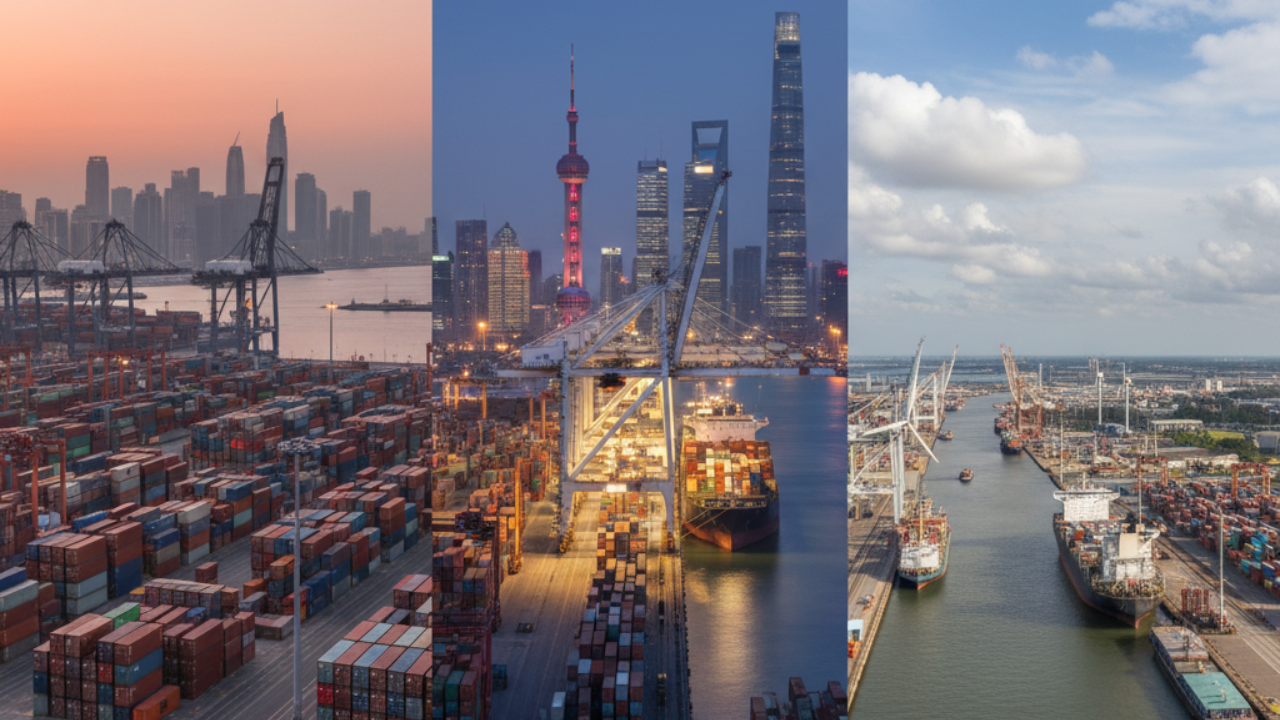
Post by : Meena Rani
Global trade continues to grow at an unprecedented pace, with major ports acting as the lifelines of international commerce. In 2025, Dubai, Shanghai, and Rotterdam remain at the forefront, competing for volume, efficiency, and technological innovation. This article explores what makes these ports the busiest in the world and how they are shaping the global trade landscape.
Dubai’s port infrastructure has evolved into a global logistics hub. Jebel Ali Port, the largest in the Middle East, handles millions of containers annually and serves as a critical link between Asia, Europe, and Africa.
Dubai’s success stems from a combination of strategic location, advanced technology, and government policies supporting trade and logistics. Automated cranes, AI-powered tracking systems, and digital customs clearance have accelerated cargo handling, reducing turnaround time for ships and increasing overall efficiency.
The port also supports free trade zones, encouraging international businesses to establish regional headquarters nearby. With expansion plans underway, Dubai aims to solidify its position as a top hub for global trade in the coming years.
Shanghai remains the world’s busiest port by container throughput, reflecting China’s role as the world’s manufacturing powerhouse. The Port of Shanghai processes over 50 million twenty-foot equivalent units (TEUs) annually, connecting domestic industries to global markets.
China’s investment in port infrastructure includes deep-water berths, automated stacking cranes, and integrated logistics networks. These innovations enable Shanghai to handle massive volumes of imports and exports efficiently.
In addition to cargo volume, Shanghai plays a key role in maritime trade finance, offering banking and insurance services that facilitate international shipping. Its position on the Yangtze River Delta also allows easy inland distribution, supporting China’s domestic supply chain and export-driven economy.
Rotterdam, known as the “Gateway to Europe,” serves as the primary port for the continent, linking European industries with international markets. The port handles approximately 15 million TEUs annually, making it Europe’s busiest and one of the world’s most technologically advanced ports.
Rotterdam stands out for sustainability initiatives, including electric cranes, energy-efficient ships, and digital platforms for customs and logistics. The port is actively integrating green energy solutions and promoting eco-friendly shipping practices, setting a benchmark for global maritime operations.
Rotterdam’s location near major industrial regions of Germany, Belgium, and France ensures it remains a critical hub for European trade, facilitating imports of raw materials and exports of manufactured goods.
Several factors determine the success and efficiency of the world’s busiest ports:
Strategic Location: Ports like Dubai, Shanghai, and Rotterdam are located near major trade routes, minimizing shipping time and fuel costs.
Technological Innovation: Automation, AI-powered tracking, and predictive logistics enhance operational efficiency.
Connectivity: Ports connected to road, rail, and inland waterways enable smooth distribution of goods.
Trade Policies: Free trade zones and regulatory support encourage international business investment.
Sustainability Initiatives: Environmental policies, green energy, and eco-friendly operations improve long-term viability.
Despite their success, these ports face challenges, including:
Congestion: High volumes can lead to delays and increased costs for shipping companies.
Geopolitical Tensions: Trade disputes or tariffs can disrupt operations and supply chains.
Technological Disruption: Ports must continuously invest in new technologies to stay competitive.
Climate Change: Rising sea levels and extreme weather events pose risks to port infrastructure.
Managing these challenges is critical for ports to maintain their leading positions in global trade.
The next decade will see continued investment in port automation, digitalization, and green energy. Dubai is expanding its logistics zones, Shanghai is improving inland waterway connections, and Rotterdam is pursuing carbon-neutral shipping initiatives.
Emerging trends include the use of AI for predictive cargo handling, blockchain for secure trade documentation, and autonomous ships that can further streamline global shipping operations. These innovations promise to enhance efficiency and reduce costs, ensuring that these ports remain central to global commerce.
Dubai, Shanghai, and Rotterdam represent the pinnacle of maritime trade efficiency, combining strategic location, technology, and infrastructure to handle massive trade volumes. In 2025, they are not only the busiest ports but also key drivers of global economic growth.
For businesses, investors, and logistics operators, understanding the operations and innovations at these ports is essential for navigating the complex world of international trade. As global commerce continues to expand, these ports will play a crucial role in connecting markets and sustaining economic development worldwide.
Global Trade, Shipping Ports, Dubai Port, Shanghai Port, Rotterdam Port, Maritime Logistics, 2025 Trade Trends










Advances in Aerospace Technology and Commercial Aviation Recovery
Insights into breakthrough aerospace technologies and commercial aviation’s recovery amid 2025 chall

Defense Modernization and Strategic Spending Trends
Explore key trends in global defense modernization and strategic military spending shaping 2025 secu

Tens of Thousands Protest in Serbia on Anniversary of Deadly Roof Collapse
Tens of thousands in Novi Sad mark a year since a deadly station roof collapse that killed 16, prote

Canada PM Carney Apologizes to Trump Over Controversial Reagan Anti-Tariff Ad
Canadian PM Mark Carney apologized to President Trump over an Ontario anti-tariff ad quoting Reagan,

The ad that stirred a hornets nest, and made Canadian PM Carney say sorry to Trump
Canadian PM Mark Carney apologizes to US President Trump after a tariff-related ad causes diplomatic

Bengaluru-Mumbai Superfast Train Approved After 30-Year Wait
Railways approves new superfast train connecting Bengaluru and Mumbai, ending a 30-year demand, easi